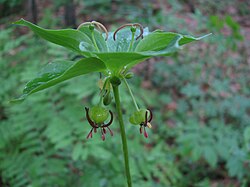| Medeoloideae | |
|---|---|
 | |
| Medeola virginiana | |
| Scientific classification | |
| Kingdom: | Plantae |
| Clade: | Tracheophytes |
| Clade: | Angiosperms |
| Clade: | Monocots |
| Order: | Liliales |
| Family: | Liliaceae |
| Subfamily: | Medeoloideae Benth. |
| Synonyms | |
Medeoleae Benth. | |
The Medeoloideae (syn. Medeoleae) are a subfamily of monocotyledon perennial, herbaceous mainly bulbous flowering plants in the lily family, Liliaceae.

